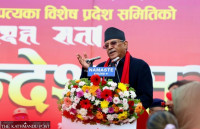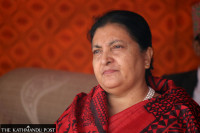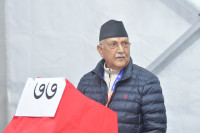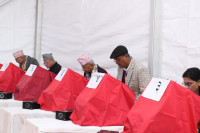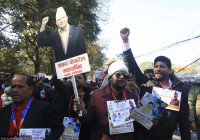Politics
How women candidates fared in local polls
Female deputy chiefs are fewer but there are more chiefs compared to last elections.
Tika R Pradhan
Even though Nepal has failed to achieve the 50 percent target of women representatives at the local level, the past elections have shown some interesting trends.
Overall, the number of elected women representatives has increased.
Of the 35,041 representatives elected from the 2017 local level polls, close to 40.95 percent (14,352) were women. This time the number has increased, but only slightly, to 14,407, which is 41.21 percent of the total elected 34,953.
As per the existing constitutional and legal provisions at least 753 women should have been elected as chiefs and deputies. A total of 13,486 ward members must be women, as two women are ensured by the constitutional and legal provisions in 6,743 wards.
Article 38 (4) of the constitution says that women will have the right to participate in all state bodies on the basis of the principle of proportional inclusion.
Section 17 (4) of the Local Level Election Act-2017 makes it mandatory for a political party to field a woman candidate for either chief or deputy chief at the local level. It also requires the political parties to field 50 percent women for chiefs and deputies of District Coordination Committees.
Similarly, Article 42 says socially backward women, Dalits, indigenous people, indigenous nationalities, Madhesis, Tharus, minorities, persons with disabilities, marginalised communities, Muslims, backward classes, gender and sexual minorities, youths, farmers, labourers, oppressed or citizens of backward regions and indigenous Khas-Arya shall have the right to participate in the state bodies on the basis of inclusive principle.
Nepal holds local elections to elect new representatives for 753 units—293 (urban) municipalities and 460 rural municipalities. Similarly, a ward chair and four members are elected for 6,743 wards all across the country.
Mayors and deputy mayors are elected in urban municipalities while chairs and vice-chairs are elected in rural municipalities. Altogether, 1,506 mayors, deputy mayors, chairs and vice chairs are elected. With ward chairs and members, a total of 35,221 representatives are elected every five years.
The number of women in mayor or chair positions has slightly increased this time, but the same in the case of deputy mayor or vice-chair positions has significantly decreased.
From the 2017 local polls, 18 women (7 mayors and 11 chairpersons) were elected as chiefs. This time, as of Thursday’s data of the Election Commission, 25 women (13 mayors and 12 chairpersons) have been elected as chiefs.
In the last elections, 718 women were elected as deputy chiefs. This time, the number has come down, with 564 women (229 deputy mayors and 335 vice-chairs) getting elected in 749 local units where counting has been completed.
In the last elections, 48.8 percent women were elected to chief and deputy chief positions but their representation this time has slipped by nine percentage points to 39.1 percent.
Only 69 women have been elected as chairpersons in 6,743 wards, which is just a little over one percent.
Of the four members envisioned for each ward, two must be women and two (either men or women) are elected under the open category.

As of Thursday, only 442 women have been elected ward members from the open category, which is 3.2 percent.
Under the Dalit category, there must be 6,743 women as ward members, but no candidacies were filed in 123 units. Last time, there were no candidacies in 176 units under the Dalit women category.
The large representation of women from the last elections was largely welcomed, but experts say Nepal is still failing to achieve the 50 percent target, largely because of a lack of will among political parties and politicians’ patriarchal mindset.
Then again, the legal loophole also gives politicians room to not field women for chief and deputy chief positions.
Although Section 17 (4) of the Local Level Election Act-2017 says a political party must field a woman as candidate for either chief or deputy chief, it says this provision does not need to be followed if parties are fielding candidates under an alliance–if a party is fielding candidate for just one of the two top posts.
Since five ruling parties had fielded candidates under an alliance during the May 13 local elections, the number of women deputy chiefs has drastically come down.
Women’s rights activists say this time female deputies were expected to fight for chief posts in most of the places but that was blocked by the parties.
“It is unfortunate that the parties failed to follow the constitutional provision,” said Archana Thapa, a women rights activist. “The Election Commission should have taken an initiative to press the parties. Also women leaders from across the political spectrum also failed to pressure their leadership.”
According to Thapa, time has come for social activists and civil society to pressure top party leaders who seem to have failed to internalise the idea of inclusivity in their parties.
“Actually we were not confident that women will get shares in governance and other fields as per the spirit of the constitution even when 91 percent of women were elected as deputies from the last local polls,” Thapa told the Post. “This time what we feared has come to pass.”




 11.12°C Kathmandu
11.12°C Kathmandu
